Report: Strategies for Developing Individuals, Teams and Organisations
VerifiedAdded on 2020/12/29
|14
|3920
|172
Report
AI Summary
This report delves into the critical aspects of developing individuals, teams, and organizations, with a specific focus on the human resource management perspective. It begins by outlining the essential knowledge, skills, and behaviors required of HR professionals, including continuous professional development and the maintenance of KSA (Knowledge, Skills, and Abilities). The report then explores personal skills audits, emphasizing their role in identifying strengths and weaknesses to create effective professional development plans. It differentiates between organizational and individual learning, training, and development, highlighting the significance of continuous learning and professional growth. Furthermore, the report examines how high-performance work (HPW) contributes to employee engagement and competitive advantage, followed by an evaluation of different approaches to performance management. Throughout, the report provides practical insights and strategies for fostering a productive and thriving organizational environment, drawing upon relevant academic literature and practical applications, such as the case study of Whirlpool.
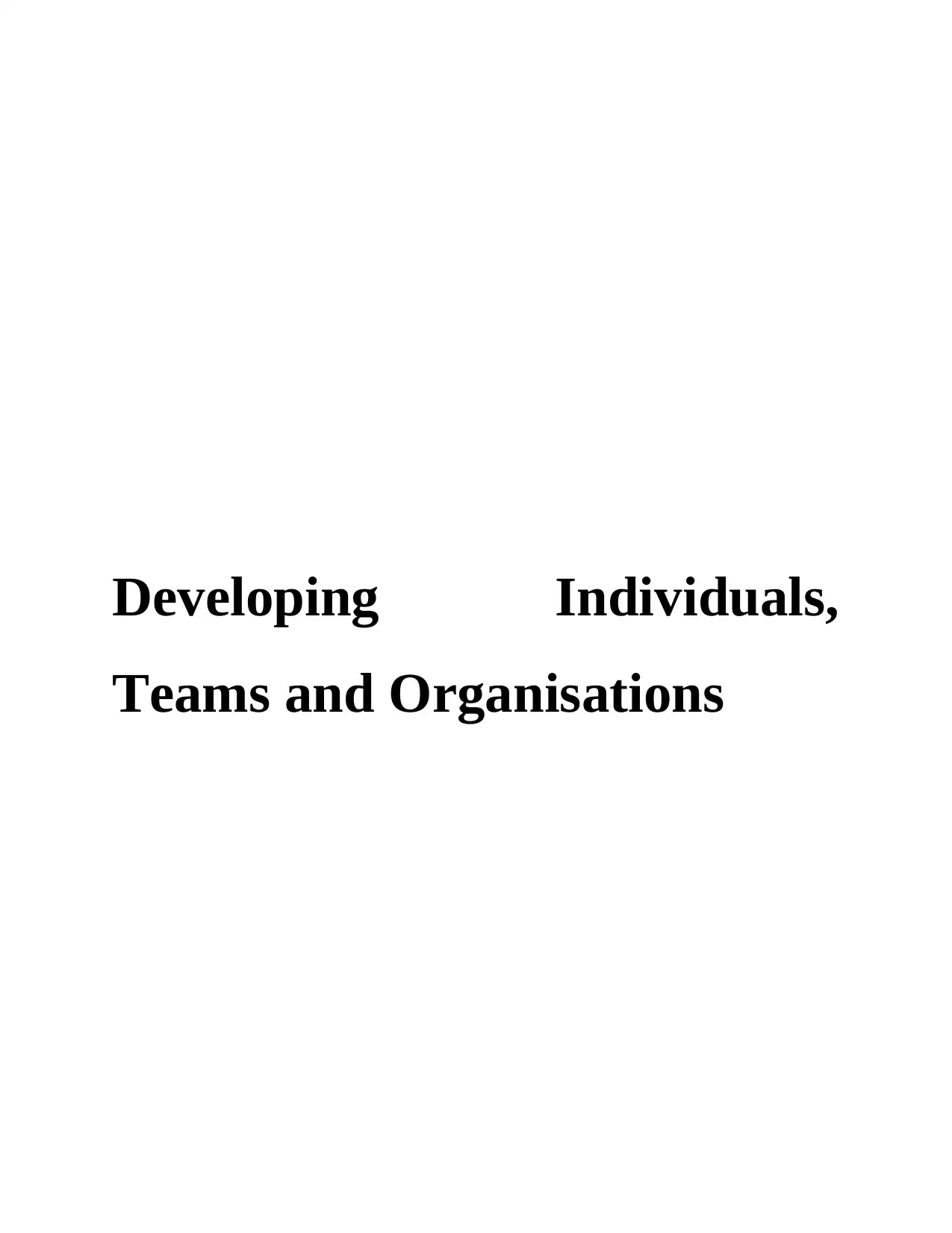
Developing Individuals,
Teams and Organisations
Teams and Organisations
Paraphrase This Document
Need a fresh take? Get an instant paraphrase of this document with our AI Paraphraser
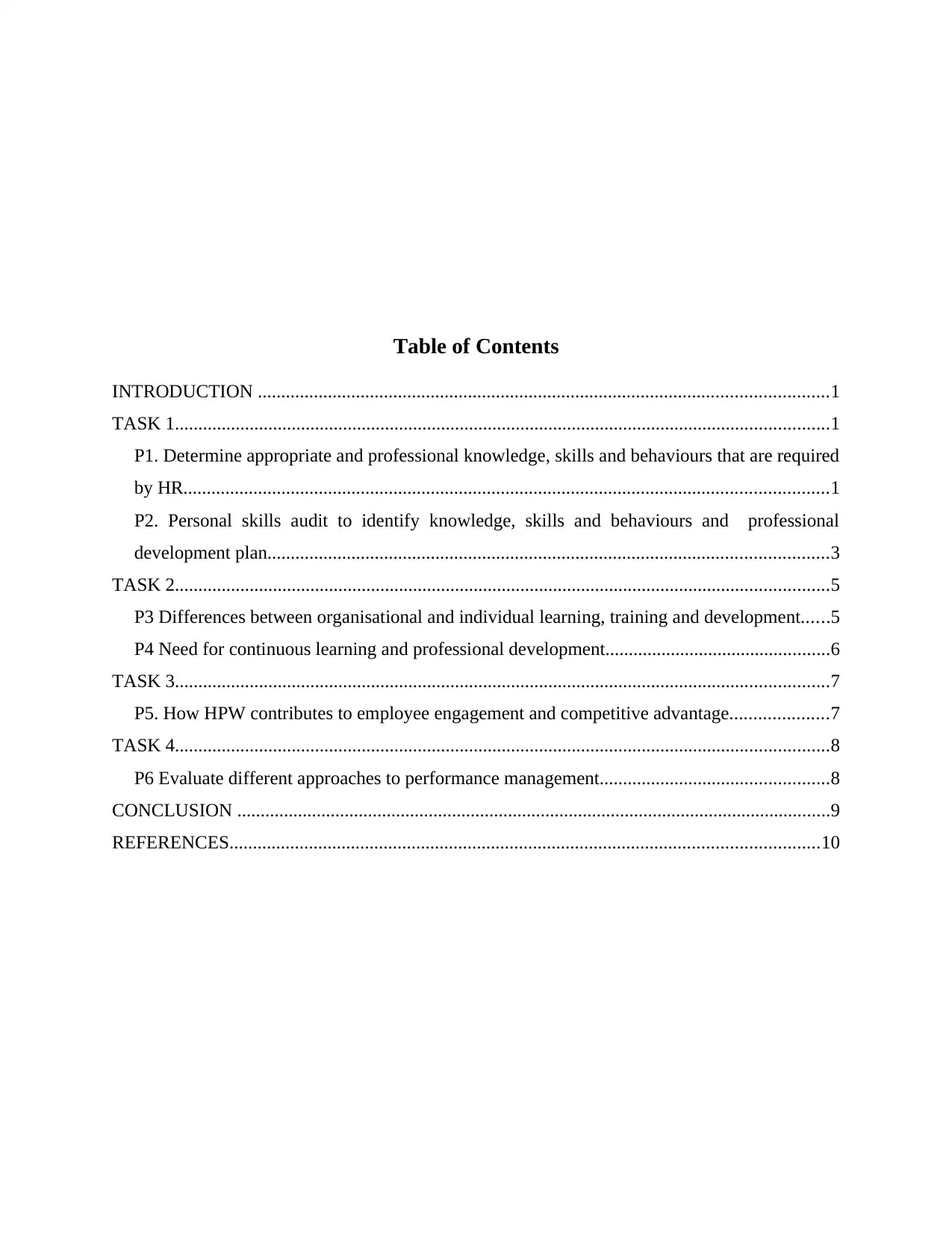
Table of Contents
INTRODUCTION ..........................................................................................................................1
TASK 1............................................................................................................................................1
P1. Determine appropriate and professional knowledge, skills and behaviours that are required
by HR..........................................................................................................................................1
P2. Personal skills audit to identify knowledge, skills and behaviours and professional
development plan........................................................................................................................3
TASK 2............................................................................................................................................5
P3 Differences between organisational and individual learning, training and development......5
P4 Need for continuous learning and professional development................................................6
TASK 3............................................................................................................................................7
P5. How HPW contributes to employee engagement and competitive advantage.....................7
TASK 4............................................................................................................................................8
P6 Evaluate different approaches to performance management.................................................8
CONCLUSION ...............................................................................................................................9
REFERENCES..............................................................................................................................10
INTRODUCTION ..........................................................................................................................1
TASK 1............................................................................................................................................1
P1. Determine appropriate and professional knowledge, skills and behaviours that are required
by HR..........................................................................................................................................1
P2. Personal skills audit to identify knowledge, skills and behaviours and professional
development plan........................................................................................................................3
TASK 2............................................................................................................................................5
P3 Differences between organisational and individual learning, training and development......5
P4 Need for continuous learning and professional development................................................6
TASK 3............................................................................................................................................7
P5. How HPW contributes to employee engagement and competitive advantage.....................7
TASK 4............................................................................................................................................8
P6 Evaluate different approaches to performance management.................................................8
CONCLUSION ...............................................................................................................................9
REFERENCES..............................................................................................................................10
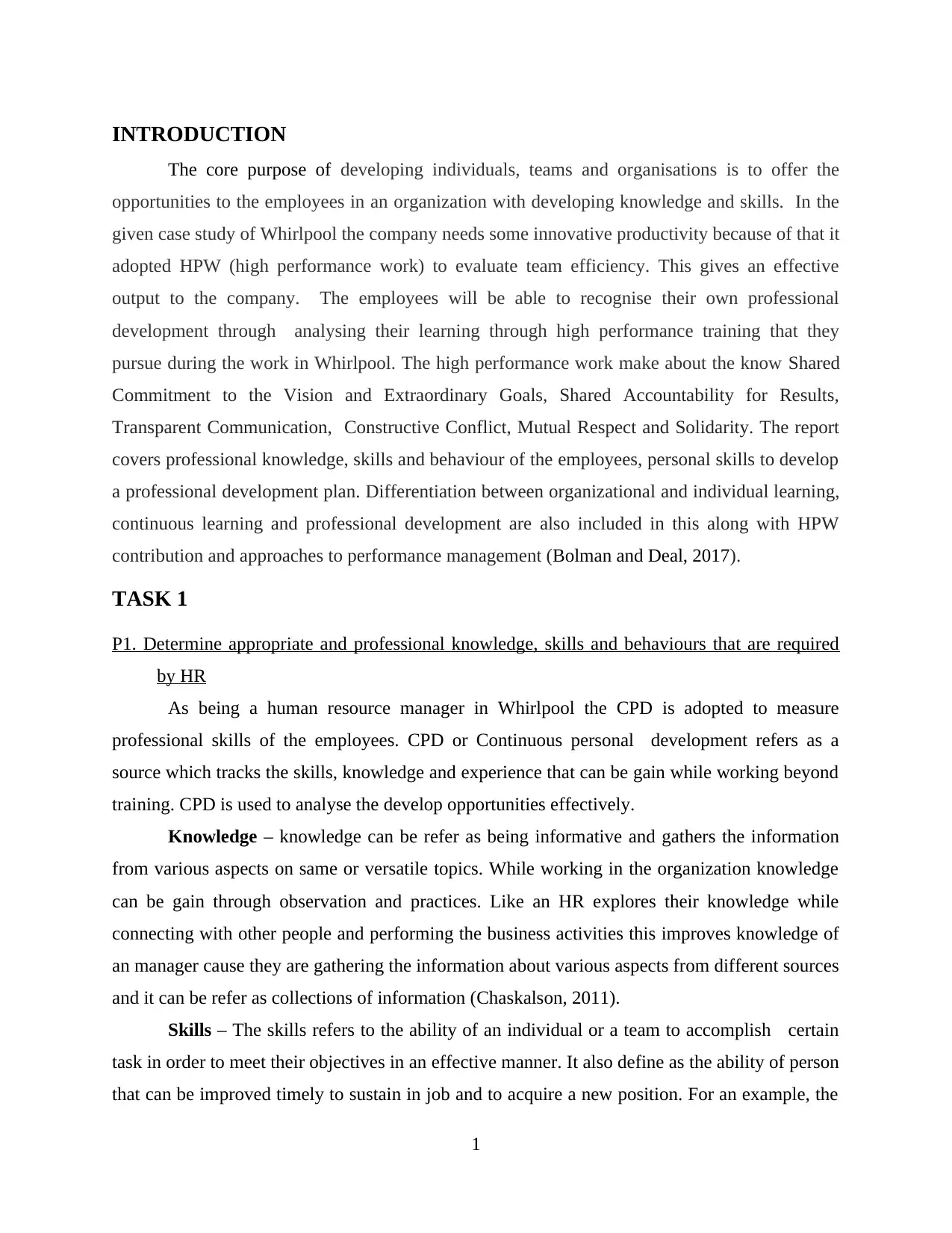
INTRODUCTION
The core purpose of developing individuals, teams and organisations is to offer the
opportunities to the employees in an organization with developing knowledge and skills. In the
given case study of Whirlpool the company needs some innovative productivity because of that it
adopted HPW (high performance work) to evaluate team efficiency. This gives an effective
output to the company. The employees will be able to recognise their own professional
development through analysing their learning through high performance training that they
pursue during the work in Whirlpool. The high performance work make about the know Shared
Commitment to the Vision and Extraordinary Goals, Shared Accountability for Results,
Transparent Communication, Constructive Conflict, Mutual Respect and Solidarity. The report
covers professional knowledge, skills and behaviour of the employees, personal skills to develop
a professional development plan. Differentiation between organizational and individual learning,
continuous learning and professional development are also included in this along with HPW
contribution and approaches to performance management (Bolman and Deal, 2017).
TASK 1
P1. Determine appropriate and professional knowledge, skills and behaviours that are required
by HR
As being a human resource manager in Whirlpool the CPD is adopted to measure
professional skills of the employees. CPD or Continuous personal development refers as a
source which tracks the skills, knowledge and experience that can be gain while working beyond
training. CPD is used to analyse the develop opportunities effectively.
Knowledge – knowledge can be refer as being informative and gathers the information
from various aspects on same or versatile topics. While working in the organization knowledge
can be gain through observation and practices. Like an HR explores their knowledge while
connecting with other people and performing the business activities this improves knowledge of
an manager cause they are gathering the information about various aspects from different sources
and it can be refer as collections of information (Chaskalson, 2011).
Skills – The skills refers to the ability of an individual or a team to accomplish certain
task in order to meet their objectives in an effective manner. It also define as the ability of person
that can be improved timely to sustain in job and to acquire a new position. For an example, the
1
The core purpose of developing individuals, teams and organisations is to offer the
opportunities to the employees in an organization with developing knowledge and skills. In the
given case study of Whirlpool the company needs some innovative productivity because of that it
adopted HPW (high performance work) to evaluate team efficiency. This gives an effective
output to the company. The employees will be able to recognise their own professional
development through analysing their learning through high performance training that they
pursue during the work in Whirlpool. The high performance work make about the know Shared
Commitment to the Vision and Extraordinary Goals, Shared Accountability for Results,
Transparent Communication, Constructive Conflict, Mutual Respect and Solidarity. The report
covers professional knowledge, skills and behaviour of the employees, personal skills to develop
a professional development plan. Differentiation between organizational and individual learning,
continuous learning and professional development are also included in this along with HPW
contribution and approaches to performance management (Bolman and Deal, 2017).
TASK 1
P1. Determine appropriate and professional knowledge, skills and behaviours that are required
by HR
As being a human resource manager in Whirlpool the CPD is adopted to measure
professional skills of the employees. CPD or Continuous personal development refers as a
source which tracks the skills, knowledge and experience that can be gain while working beyond
training. CPD is used to analyse the develop opportunities effectively.
Knowledge – knowledge can be refer as being informative and gathers the information
from various aspects on same or versatile topics. While working in the organization knowledge
can be gain through observation and practices. Like an HR explores their knowledge while
connecting with other people and performing the business activities this improves knowledge of
an manager cause they are gathering the information about various aspects from different sources
and it can be refer as collections of information (Chaskalson, 2011).
Skills – The skills refers to the ability of an individual or a team to accomplish certain
task in order to meet their objectives in an effective manner. It also define as the ability of person
that can be improved timely to sustain in job and to acquire a new position. For an example, the
1
⊘ This is a preview!⊘
Do you want full access?
Subscribe today to unlock all pages.

Trusted by 1+ million students worldwide
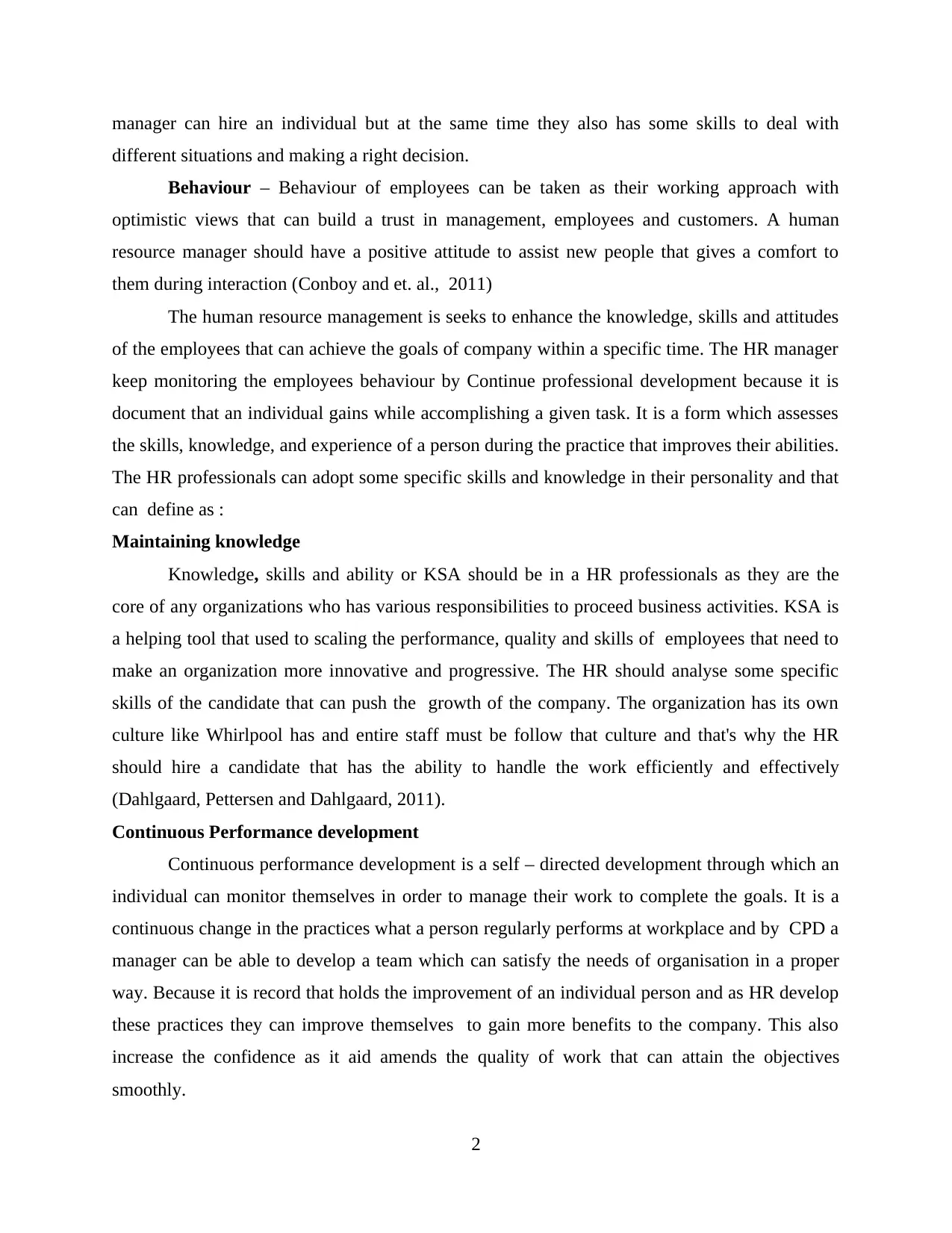
manager can hire an individual but at the same time they also has some skills to deal with
different situations and making a right decision.
Behaviour – Behaviour of employees can be taken as their working approach with
optimistic views that can build a trust in management, employees and customers. A human
resource manager should have a positive attitude to assist new people that gives a comfort to
them during interaction (Conboy and et. al., 2011)
The human resource management is seeks to enhance the knowledge, skills and attitudes
of the employees that can achieve the goals of company within a specific time. The HR manager
keep monitoring the employees behaviour by Continue professional development because it is
document that an individual gains while accomplishing a given task. It is a form which assesses
the skills, knowledge, and experience of a person during the practice that improves their abilities.
The HR professionals can adopt some specific skills and knowledge in their personality and that
can define as :
Maintaining knowledge
Knowledge, skills and ability or KSA should be in a HR professionals as they are the
core of any organizations who has various responsibilities to proceed business activities. KSA is
a helping tool that used to scaling the performance, quality and skills of employees that need to
make an organization more innovative and progressive. The HR should analyse some specific
skills of the candidate that can push the growth of the company. The organization has its own
culture like Whirlpool has and entire staff must be follow that culture and that's why the HR
should hire a candidate that has the ability to handle the work efficiently and effectively
(Dahlgaard, Pettersen and Dahlgaard, 2011).
Continuous Performance development
Continuous performance development is a self – directed development through which an
individual can monitor themselves in order to manage their work to complete the goals. It is a
continuous change in the practices what a person regularly performs at workplace and by CPD a
manager can be able to develop a team which can satisfy the needs of organisation in a proper
way. Because it is record that holds the improvement of an individual person and as HR develop
these practices they can improve themselves to gain more benefits to the company. This also
increase the confidence as it aid amends the quality of work that can attain the objectives
smoothly.
2
different situations and making a right decision.
Behaviour – Behaviour of employees can be taken as their working approach with
optimistic views that can build a trust in management, employees and customers. A human
resource manager should have a positive attitude to assist new people that gives a comfort to
them during interaction (Conboy and et. al., 2011)
The human resource management is seeks to enhance the knowledge, skills and attitudes
of the employees that can achieve the goals of company within a specific time. The HR manager
keep monitoring the employees behaviour by Continue professional development because it is
document that an individual gains while accomplishing a given task. It is a form which assesses
the skills, knowledge, and experience of a person during the practice that improves their abilities.
The HR professionals can adopt some specific skills and knowledge in their personality and that
can define as :
Maintaining knowledge
Knowledge, skills and ability or KSA should be in a HR professionals as they are the
core of any organizations who has various responsibilities to proceed business activities. KSA is
a helping tool that used to scaling the performance, quality and skills of employees that need to
make an organization more innovative and progressive. The HR should analyse some specific
skills of the candidate that can push the growth of the company. The organization has its own
culture like Whirlpool has and entire staff must be follow that culture and that's why the HR
should hire a candidate that has the ability to handle the work efficiently and effectively
(Dahlgaard, Pettersen and Dahlgaard, 2011).
Continuous Performance development
Continuous performance development is a self – directed development through which an
individual can monitor themselves in order to manage their work to complete the goals. It is a
continuous change in the practices what a person regularly performs at workplace and by CPD a
manager can be able to develop a team which can satisfy the needs of organisation in a proper
way. Because it is record that holds the improvement of an individual person and as HR develop
these practices they can improve themselves to gain more benefits to the company. This also
increase the confidence as it aid amends the quality of work that can attain the objectives
smoothly.
2
Paraphrase This Document
Need a fresh take? Get an instant paraphrase of this document with our AI Paraphraser
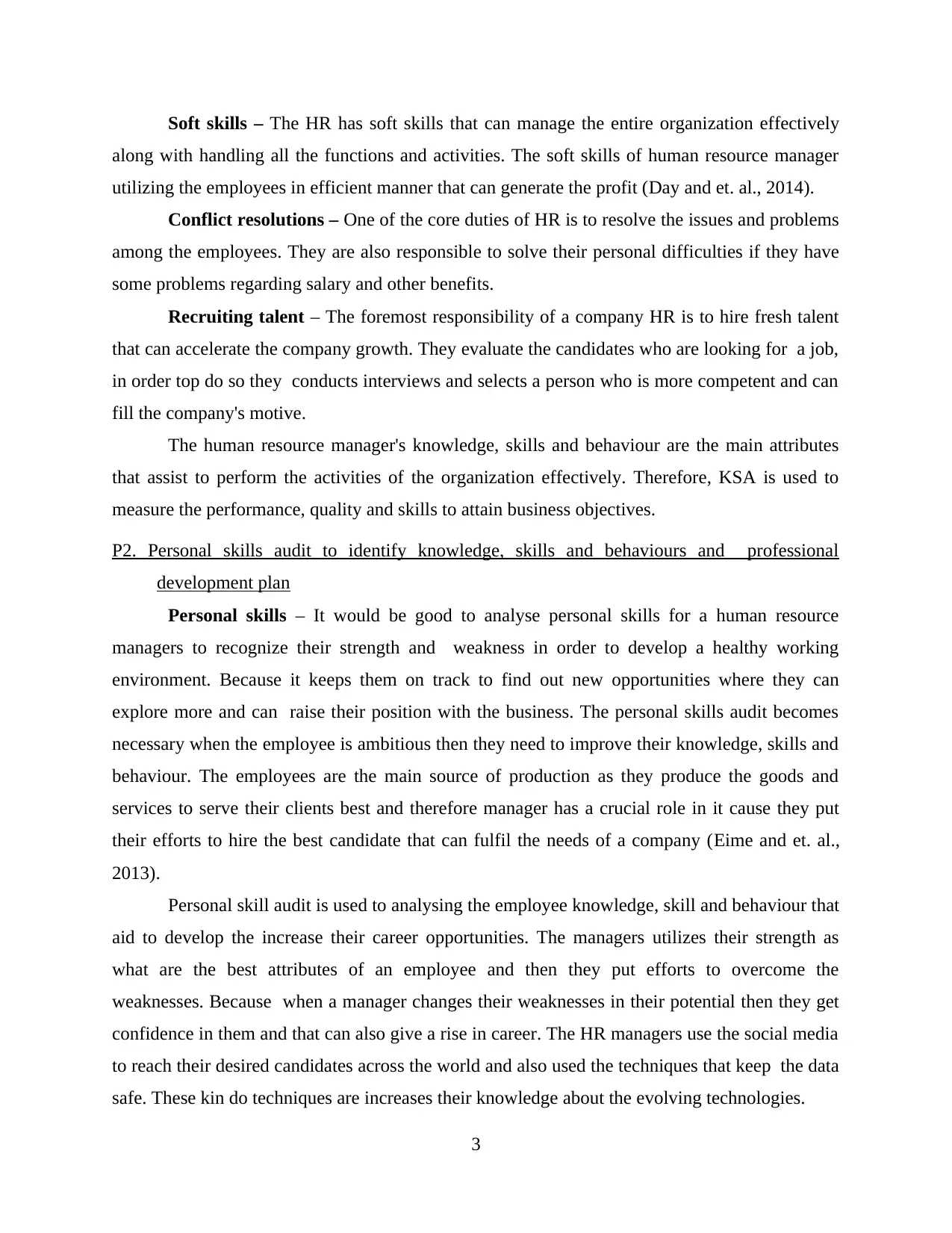
Soft skills – The HR has soft skills that can manage the entire organization effectively
along with handling all the functions and activities. The soft skills of human resource manager
utilizing the employees in efficient manner that can generate the profit (Day and et. al., 2014).
Conflict resolutions – One of the core duties of HR is to resolve the issues and problems
among the employees. They are also responsible to solve their personal difficulties if they have
some problems regarding salary and other benefits.
Recruiting talent – The foremost responsibility of a company HR is to hire fresh talent
that can accelerate the company growth. They evaluate the candidates who are looking for a job,
in order top do so they conducts interviews and selects a person who is more competent and can
fill the company's motive.
The human resource manager's knowledge, skills and behaviour are the main attributes
that assist to perform the activities of the organization effectively. Therefore, KSA is used to
measure the performance, quality and skills to attain business objectives.
P2. Personal skills audit to identify knowledge, skills and behaviours and professional
development plan
Personal skills – It would be good to analyse personal skills for a human resource
managers to recognize their strength and weakness in order to develop a healthy working
environment. Because it keeps them on track to find out new opportunities where they can
explore more and can raise their position with the business. The personal skills audit becomes
necessary when the employee is ambitious then they need to improve their knowledge, skills and
behaviour. The employees are the main source of production as they produce the goods and
services to serve their clients best and therefore manager has a crucial role in it cause they put
their efforts to hire the best candidate that can fulfil the needs of a company (Eime and et. al.,
2013).
Personal skill audit is used to analysing the employee knowledge, skill and behaviour that
aid to develop the increase their career opportunities. The managers utilizes their strength as
what are the best attributes of an employee and then they put efforts to overcome the
weaknesses. Because when a manager changes their weaknesses in their potential then they get
confidence in them and that can also give a rise in career. The HR managers use the social media
to reach their desired candidates across the world and also used the techniques that keep the data
safe. These kin do techniques are increases their knowledge about the evolving technologies.
3
along with handling all the functions and activities. The soft skills of human resource manager
utilizing the employees in efficient manner that can generate the profit (Day and et. al., 2014).
Conflict resolutions – One of the core duties of HR is to resolve the issues and problems
among the employees. They are also responsible to solve their personal difficulties if they have
some problems regarding salary and other benefits.
Recruiting talent – The foremost responsibility of a company HR is to hire fresh talent
that can accelerate the company growth. They evaluate the candidates who are looking for a job,
in order top do so they conducts interviews and selects a person who is more competent and can
fill the company's motive.
The human resource manager's knowledge, skills and behaviour are the main attributes
that assist to perform the activities of the organization effectively. Therefore, KSA is used to
measure the performance, quality and skills to attain business objectives.
P2. Personal skills audit to identify knowledge, skills and behaviours and professional
development plan
Personal skills – It would be good to analyse personal skills for a human resource
managers to recognize their strength and weakness in order to develop a healthy working
environment. Because it keeps them on track to find out new opportunities where they can
explore more and can raise their position with the business. The personal skills audit becomes
necessary when the employee is ambitious then they need to improve their knowledge, skills and
behaviour. The employees are the main source of production as they produce the goods and
services to serve their clients best and therefore manager has a crucial role in it cause they put
their efforts to hire the best candidate that can fulfil the needs of a company (Eime and et. al.,
2013).
Personal skill audit is used to analysing the employee knowledge, skill and behaviour that
aid to develop the increase their career opportunities. The managers utilizes their strength as
what are the best attributes of an employee and then they put efforts to overcome the
weaknesses. Because when a manager changes their weaknesses in their potential then they get
confidence in them and that can also give a rise in career. The HR managers use the social media
to reach their desired candidates across the world and also used the techniques that keep the data
safe. These kin do techniques are increases their knowledge about the evolving technologies.
3
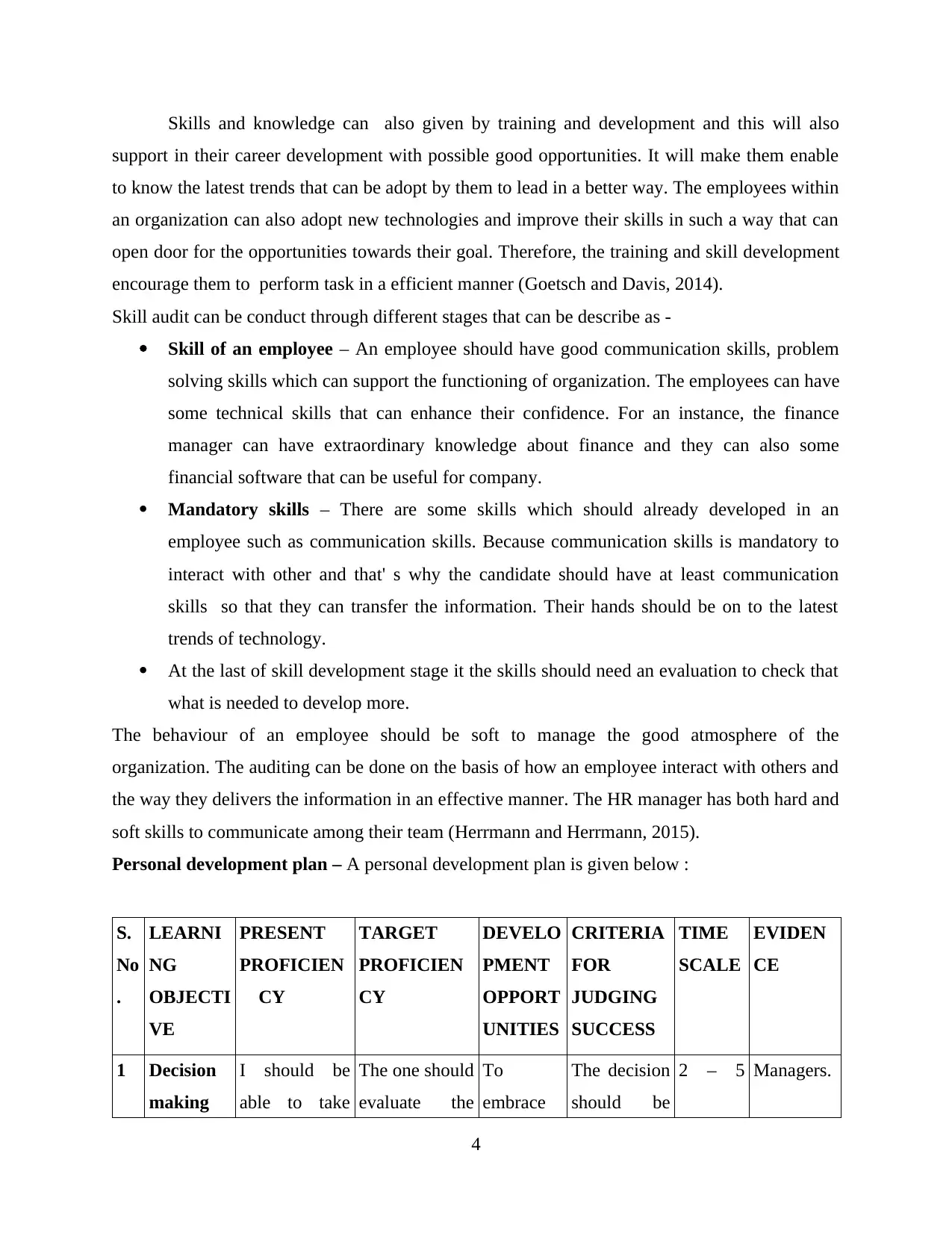
Skills and knowledge can also given by training and development and this will also
support in their career development with possible good opportunities. It will make them enable
to know the latest trends that can be adopt by them to lead in a better way. The employees within
an organization can also adopt new technologies and improve their skills in such a way that can
open door for the opportunities towards their goal. Therefore, the training and skill development
encourage them to perform task in a efficient manner (Goetsch and Davis, 2014).
Skill audit can be conduct through different stages that can be describe as -
Skill of an employee – An employee should have good communication skills, problem
solving skills which can support the functioning of organization. The employees can have
some technical skills that can enhance their confidence. For an instance, the finance
manager can have extraordinary knowledge about finance and they can also some
financial software that can be useful for company.
Mandatory skills – There are some skills which should already developed in an
employee such as communication skills. Because communication skills is mandatory to
interact with other and that' s why the candidate should have at least communication
skills so that they can transfer the information. Their hands should be on to the latest
trends of technology.
At the last of skill development stage it the skills should need an evaluation to check that
what is needed to develop more.
The behaviour of an employee should be soft to manage the good atmosphere of the
organization. The auditing can be done on the basis of how an employee interact with others and
the way they delivers the information in an effective manner. The HR manager has both hard and
soft skills to communicate among their team (Herrmann and Herrmann, 2015).
Personal development plan – A personal development plan is given below :
S.
No
.
LEARNI
NG
OBJECTI
VE
PRESENT
PROFICIEN
CY
TARGET
PROFICIEN
CY
DEVELO
PMENT
OPPORT
UNITIES
CRITERIA
FOR
JUDGING
SUCCESS
TIME
SCALE
EVIDEN
CE
1 Decision
making
I should be
able to take
The one should
evaluate the
To
embrace
The decision
should be
2 – 5 Managers.
4
support in their career development with possible good opportunities. It will make them enable
to know the latest trends that can be adopt by them to lead in a better way. The employees within
an organization can also adopt new technologies and improve their skills in such a way that can
open door for the opportunities towards their goal. Therefore, the training and skill development
encourage them to perform task in a efficient manner (Goetsch and Davis, 2014).
Skill audit can be conduct through different stages that can be describe as -
Skill of an employee – An employee should have good communication skills, problem
solving skills which can support the functioning of organization. The employees can have
some technical skills that can enhance their confidence. For an instance, the finance
manager can have extraordinary knowledge about finance and they can also some
financial software that can be useful for company.
Mandatory skills – There are some skills which should already developed in an
employee such as communication skills. Because communication skills is mandatory to
interact with other and that' s why the candidate should have at least communication
skills so that they can transfer the information. Their hands should be on to the latest
trends of technology.
At the last of skill development stage it the skills should need an evaluation to check that
what is needed to develop more.
The behaviour of an employee should be soft to manage the good atmosphere of the
organization. The auditing can be done on the basis of how an employee interact with others and
the way they delivers the information in an effective manner. The HR manager has both hard and
soft skills to communicate among their team (Herrmann and Herrmann, 2015).
Personal development plan – A personal development plan is given below :
S.
No
.
LEARNI
NG
OBJECTI
VE
PRESENT
PROFICIEN
CY
TARGET
PROFICIEN
CY
DEVELO
PMENT
OPPORT
UNITIES
CRITERIA
FOR
JUDGING
SUCCESS
TIME
SCALE
EVIDEN
CE
1 Decision
making
I should be
able to take
The one should
evaluate the
To
embrace
The decision
should be
2 – 5 Managers.
4
⊘ This is a preview!⊘
Do you want full access?
Subscribe today to unlock all pages.

Trusted by 1+ million students worldwide
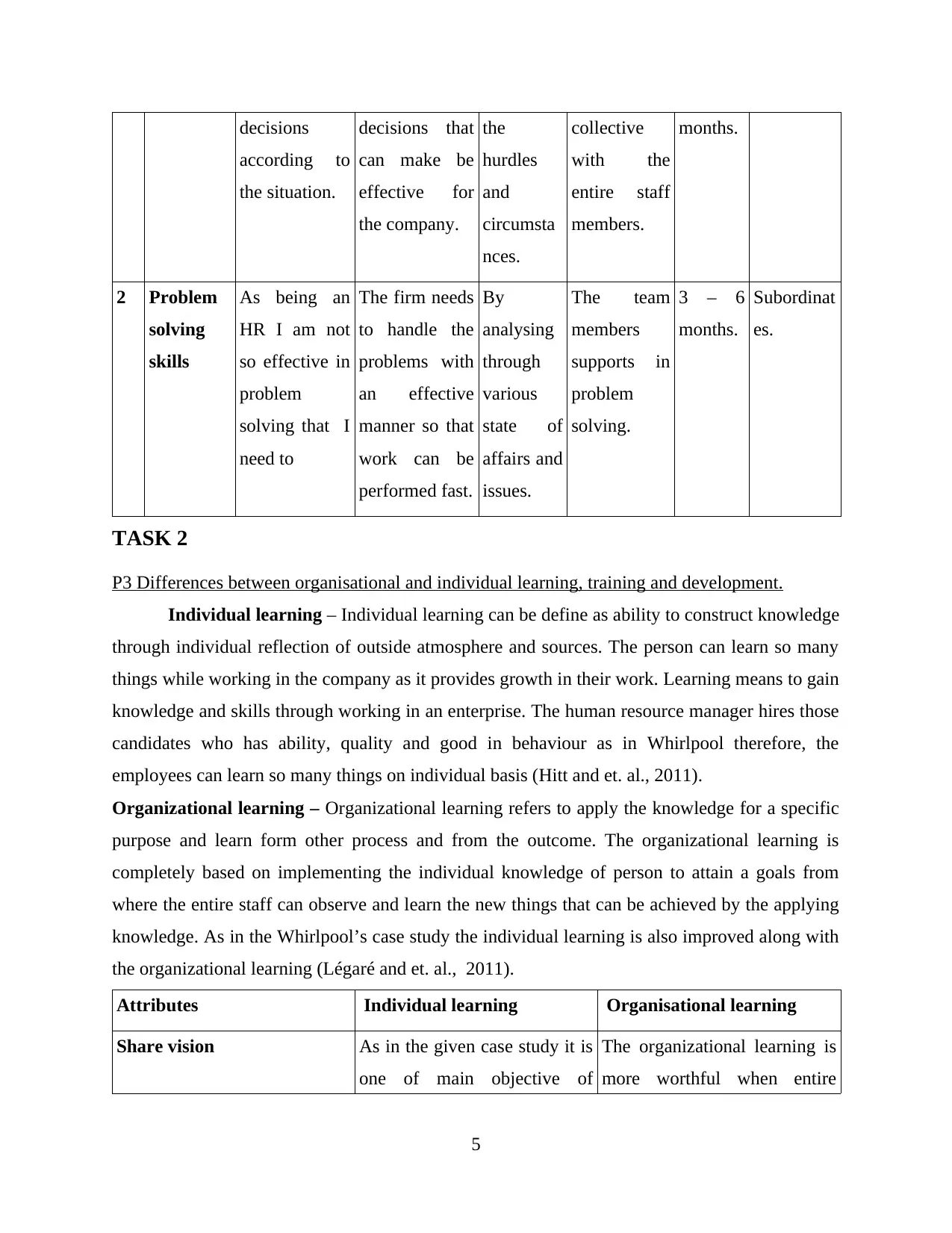
decisions
according to
the situation.
decisions that
can make be
effective for
the company.
the
hurdles
and
circumsta
nces.
collective
with the
entire staff
members.
months.
2 Problem
solving
skills
As being an
HR I am not
so effective in
problem
solving that I
need to
The firm needs
to handle the
problems with
an effective
manner so that
work can be
performed fast.
By
analysing
through
various
state of
affairs and
issues.
The team
members
supports in
problem
solving.
3 – 6
months.
Subordinat
es.
TASK 2
P3 Differences between organisational and individual learning, training and development.
Individual learning – Individual learning can be define as ability to construct knowledge
through individual reflection of outside atmosphere and sources. The person can learn so many
things while working in the company as it provides growth in their work. Learning means to gain
knowledge and skills through working in an enterprise. The human resource manager hires those
candidates who has ability, quality and good in behaviour as in Whirlpool therefore, the
employees can learn so many things on individual basis (Hitt and et. al., 2011).
Organizational learning – Organizational learning refers to apply the knowledge for a specific
purpose and learn form other process and from the outcome. The organizational learning is
completely based on implementing the individual knowledge of person to attain a goals from
where the entire staff can observe and learn the new things that can be achieved by the applying
knowledge. As in the Whirlpool’s case study the individual learning is also improved along with
the organizational learning (Légaré and et. al., 2011).
Attributes Individual learning Organisational learning
Share vision As in the given case study it is
one of main objective of
The organizational learning is
more worthful when entire
5
according to
the situation.
decisions that
can make be
effective for
the company.
the
hurdles
and
circumsta
nces.
collective
with the
entire staff
members.
months.
2 Problem
solving
skills
As being an
HR I am not
so effective in
problem
solving that I
need to
The firm needs
to handle the
problems with
an effective
manner so that
work can be
performed fast.
By
analysing
through
various
state of
affairs and
issues.
The team
members
supports in
problem
solving.
3 – 6
months.
Subordinat
es.
TASK 2
P3 Differences between organisational and individual learning, training and development.
Individual learning – Individual learning can be define as ability to construct knowledge
through individual reflection of outside atmosphere and sources. The person can learn so many
things while working in the company as it provides growth in their work. Learning means to gain
knowledge and skills through working in an enterprise. The human resource manager hires those
candidates who has ability, quality and good in behaviour as in Whirlpool therefore, the
employees can learn so many things on individual basis (Hitt and et. al., 2011).
Organizational learning – Organizational learning refers to apply the knowledge for a specific
purpose and learn form other process and from the outcome. The organizational learning is
completely based on implementing the individual knowledge of person to attain a goals from
where the entire staff can observe and learn the new things that can be achieved by the applying
knowledge. As in the Whirlpool’s case study the individual learning is also improved along with
the organizational learning (Légaré and et. al., 2011).
Attributes Individual learning Organisational learning
Share vision As in the given case study it is
one of main objective of
The organizational learning is
more worthful when entire
5
Paraphrase This Document
Need a fresh take? Get an instant paraphrase of this document with our AI Paraphraser
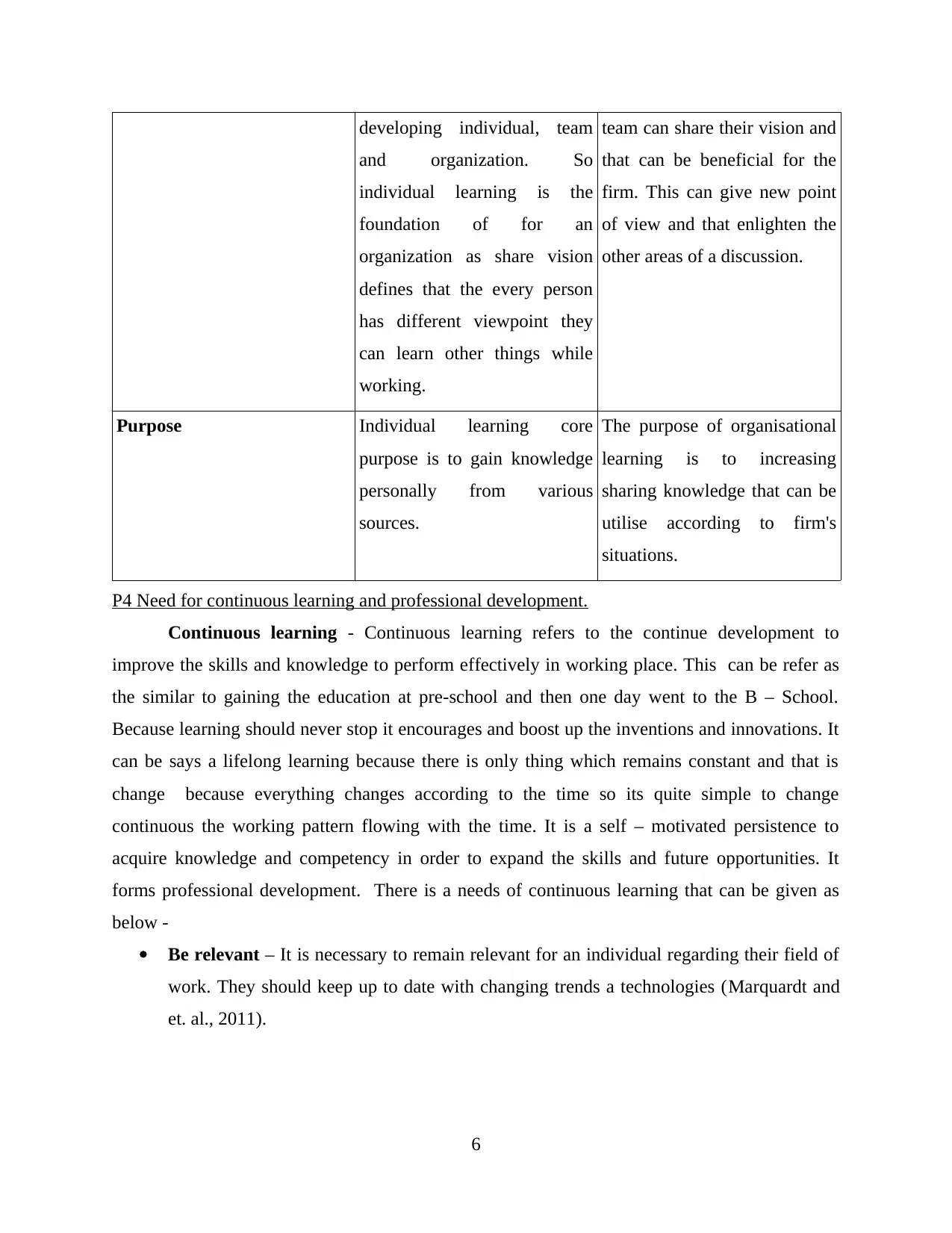
developing individual, team
and organization. So
individual learning is the
foundation of for an
organization as share vision
defines that the every person
has different viewpoint they
can learn other things while
working.
team can share their vision and
that can be beneficial for the
firm. This can give new point
of view and that enlighten the
other areas of a discussion.
Purpose Individual learning core
purpose is to gain knowledge
personally from various
sources.
The purpose of organisational
learning is to increasing
sharing knowledge that can be
utilise according to firm's
situations.
P4 Need for continuous learning and professional development.
Continuous learning - Continuous learning refers to the continue development to
improve the skills and knowledge to perform effectively in working place. This can be refer as
the similar to gaining the education at pre-school and then one day went to the B – School.
Because learning should never stop it encourages and boost up the inventions and innovations. It
can be says a lifelong learning because there is only thing which remains constant and that is
change because everything changes according to the time so its quite simple to change
continuous the working pattern flowing with the time. It is a self – motivated persistence to
acquire knowledge and competency in order to expand the skills and future opportunities. It
forms professional development. There is a needs of continuous learning that can be given as
below -
Be relevant – It is necessary to remain relevant for an individual regarding their field of
work. They should keep up to date with changing trends a technologies (Marquardt and
et. al., 2011).
6
and organization. So
individual learning is the
foundation of for an
organization as share vision
defines that the every person
has different viewpoint they
can learn other things while
working.
team can share their vision and
that can be beneficial for the
firm. This can give new point
of view and that enlighten the
other areas of a discussion.
Purpose Individual learning core
purpose is to gain knowledge
personally from various
sources.
The purpose of organisational
learning is to increasing
sharing knowledge that can be
utilise according to firm's
situations.
P4 Need for continuous learning and professional development.
Continuous learning - Continuous learning refers to the continue development to
improve the skills and knowledge to perform effectively in working place. This can be refer as
the similar to gaining the education at pre-school and then one day went to the B – School.
Because learning should never stop it encourages and boost up the inventions and innovations. It
can be says a lifelong learning because there is only thing which remains constant and that is
change because everything changes according to the time so its quite simple to change
continuous the working pattern flowing with the time. It is a self – motivated persistence to
acquire knowledge and competency in order to expand the skills and future opportunities. It
forms professional development. There is a needs of continuous learning that can be given as
below -
Be relevant – It is necessary to remain relevant for an individual regarding their field of
work. They should keep up to date with changing trends a technologies (Marquardt and
et. al., 2011).
6
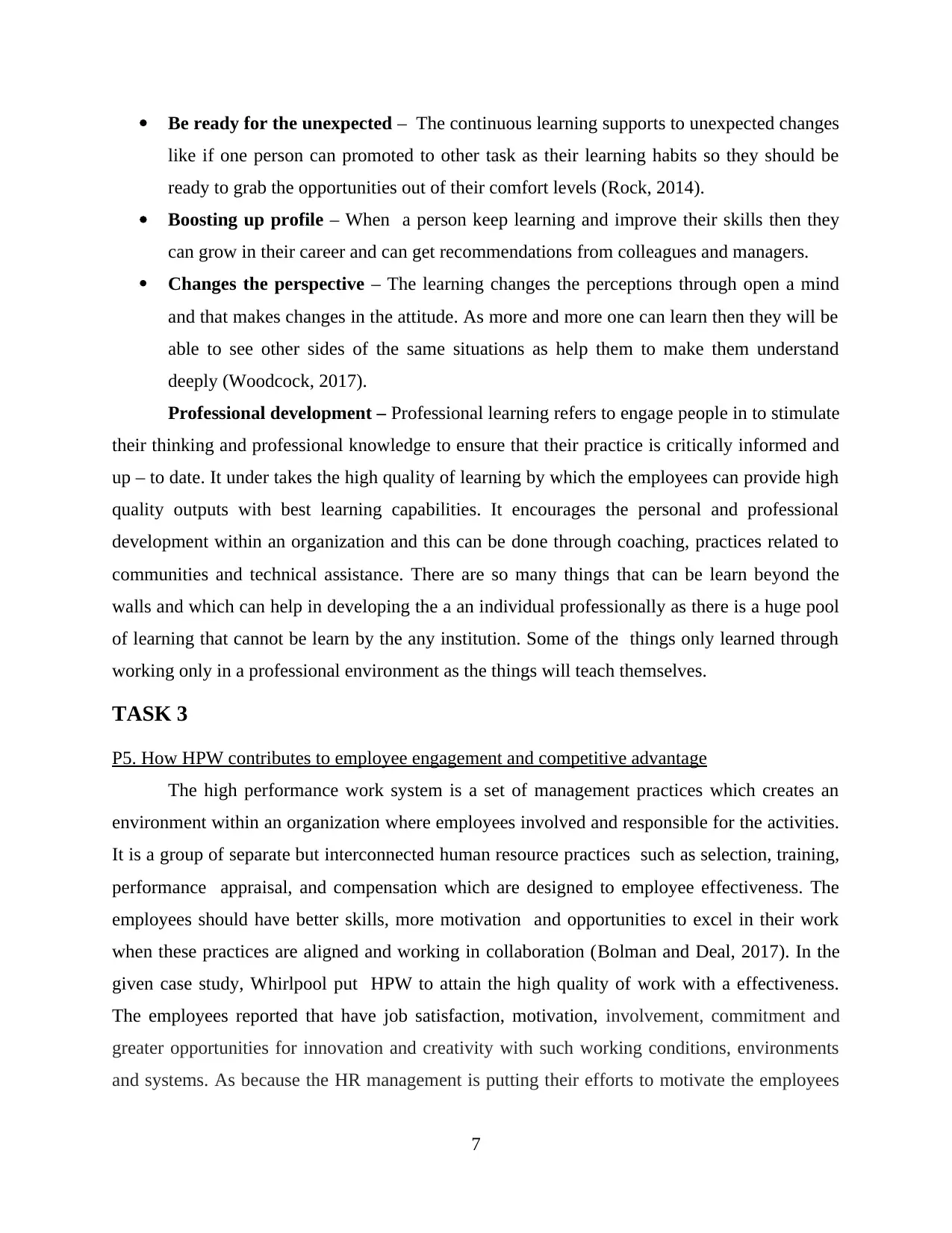
Be ready for the unexpected – The continuous learning supports to unexpected changes
like if one person can promoted to other task as their learning habits so they should be
ready to grab the opportunities out of their comfort levels (Rock, 2014).
Boosting up profile – When a person keep learning and improve their skills then they
can grow in their career and can get recommendations from colleagues and managers.
Changes the perspective – The learning changes the perceptions through open a mind
and that makes changes in the attitude. As more and more one can learn then they will be
able to see other sides of the same situations as help them to make them understand
deeply (Woodcock, 2017).
Professional development – Professional learning refers to engage people in to stimulate
their thinking and professional knowledge to ensure that their practice is critically informed and
up – to date. It under takes the high quality of learning by which the employees can provide high
quality outputs with best learning capabilities. It encourages the personal and professional
development within an organization and this can be done through coaching, practices related to
communities and technical assistance. There are so many things that can be learn beyond the
walls and which can help in developing the a an individual professionally as there is a huge pool
of learning that cannot be learn by the any institution. Some of the things only learned through
working only in a professional environment as the things will teach themselves.
TASK 3
P5. How HPW contributes to employee engagement and competitive advantage
The high performance work system is a set of management practices which creates an
environment within an organization where employees involved and responsible for the activities.
It is a group of separate but interconnected human resource practices such as selection, training,
performance appraisal, and compensation which are designed to employee effectiveness. The
employees should have better skills, more motivation and opportunities to excel in their work
when these practices are aligned and working in collaboration (Bolman and Deal, 2017). In the
given case study, Whirlpool put HPW to attain the high quality of work with a effectiveness.
The employees reported that have job satisfaction, motivation, involvement, commitment and
greater opportunities for innovation and creativity with such working conditions, environments
and systems. As because the HR management is putting their efforts to motivate the employees
7
like if one person can promoted to other task as their learning habits so they should be
ready to grab the opportunities out of their comfort levels (Rock, 2014).
Boosting up profile – When a person keep learning and improve their skills then they
can grow in their career and can get recommendations from colleagues and managers.
Changes the perspective – The learning changes the perceptions through open a mind
and that makes changes in the attitude. As more and more one can learn then they will be
able to see other sides of the same situations as help them to make them understand
deeply (Woodcock, 2017).
Professional development – Professional learning refers to engage people in to stimulate
their thinking and professional knowledge to ensure that their practice is critically informed and
up – to date. It under takes the high quality of learning by which the employees can provide high
quality outputs with best learning capabilities. It encourages the personal and professional
development within an organization and this can be done through coaching, practices related to
communities and technical assistance. There are so many things that can be learn beyond the
walls and which can help in developing the a an individual professionally as there is a huge pool
of learning that cannot be learn by the any institution. Some of the things only learned through
working only in a professional environment as the things will teach themselves.
TASK 3
P5. How HPW contributes to employee engagement and competitive advantage
The high performance work system is a set of management practices which creates an
environment within an organization where employees involved and responsible for the activities.
It is a group of separate but interconnected human resource practices such as selection, training,
performance appraisal, and compensation which are designed to employee effectiveness. The
employees should have better skills, more motivation and opportunities to excel in their work
when these practices are aligned and working in collaboration (Bolman and Deal, 2017). In the
given case study, Whirlpool put HPW to attain the high quality of work with a effectiveness.
The employees reported that have job satisfaction, motivation, involvement, commitment and
greater opportunities for innovation and creativity with such working conditions, environments
and systems. As because the HR management is putting their efforts to motivate the employees
7
⊘ This is a preview!⊘
Do you want full access?
Subscribe today to unlock all pages.

Trusted by 1+ million students worldwide
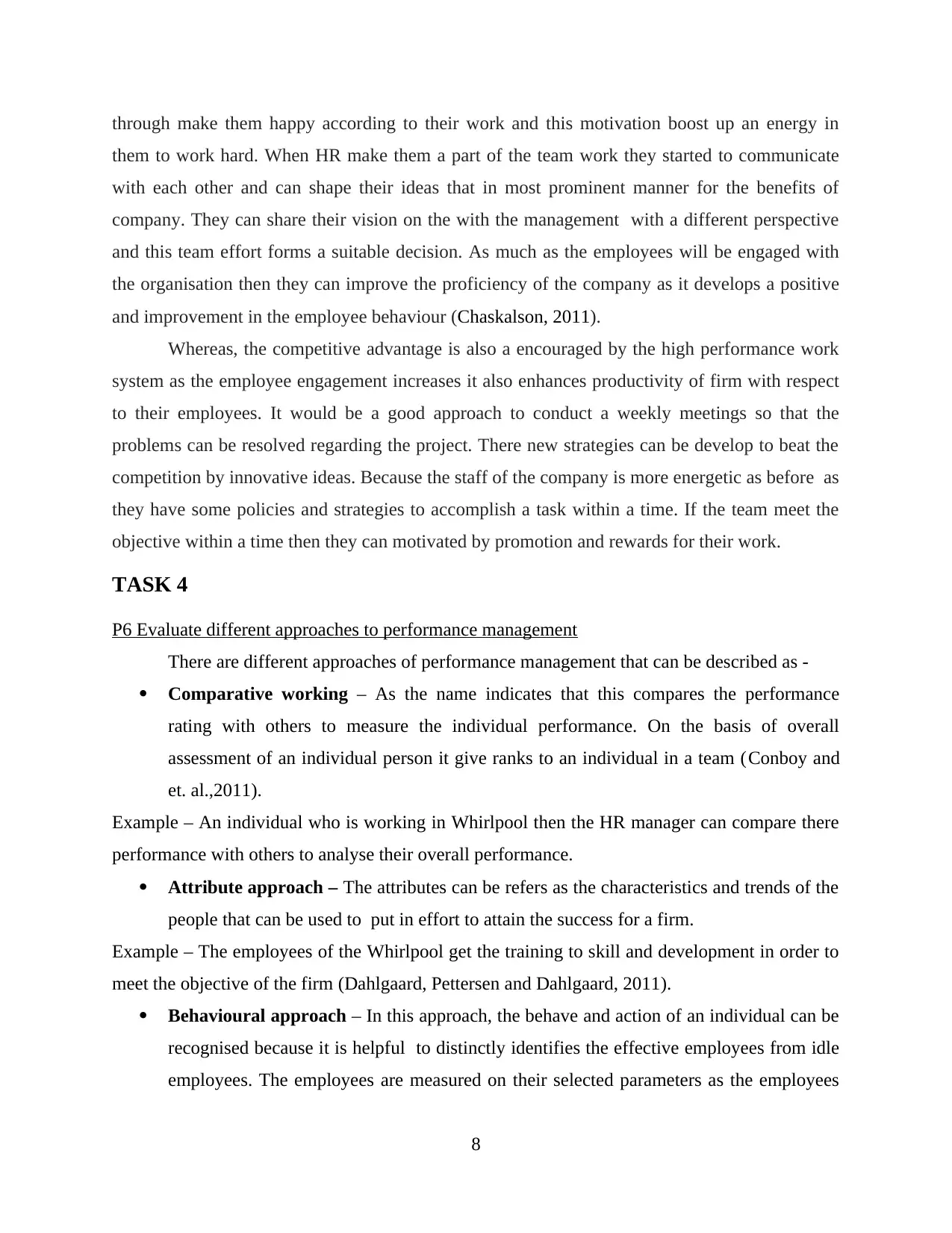
through make them happy according to their work and this motivation boost up an energy in
them to work hard. When HR make them a part of the team work they started to communicate
with each other and can shape their ideas that in most prominent manner for the benefits of
company. They can share their vision on the with the management with a different perspective
and this team effort forms a suitable decision. As much as the employees will be engaged with
the organisation then they can improve the proficiency of the company as it develops a positive
and improvement in the employee behaviour (Chaskalson, 2011).
Whereas, the competitive advantage is also a encouraged by the high performance work
system as the employee engagement increases it also enhances productivity of firm with respect
to their employees. It would be a good approach to conduct a weekly meetings so that the
problems can be resolved regarding the project. There new strategies can be develop to beat the
competition by innovative ideas. Because the staff of the company is more energetic as before as
they have some policies and strategies to accomplish a task within a time. If the team meet the
objective within a time then they can motivated by promotion and rewards for their work.
TASK 4
P6 Evaluate different approaches to performance management
There are different approaches of performance management that can be described as -
Comparative working – As the name indicates that this compares the performance
rating with others to measure the individual performance. On the basis of overall
assessment of an individual person it give ranks to an individual in a team (Conboy and
et. al.,2011).
Example – An individual who is working in Whirlpool then the HR manager can compare there
performance with others to analyse their overall performance.
Attribute approach – The attributes can be refers as the characteristics and trends of the
people that can be used to put in effort to attain the success for a firm.
Example – The employees of the Whirlpool get the training to skill and development in order to
meet the objective of the firm (Dahlgaard, Pettersen and Dahlgaard, 2011).
Behavioural approach – In this approach, the behave and action of an individual can be
recognised because it is helpful to distinctly identifies the effective employees from idle
employees. The employees are measured on their selected parameters as the employees
8
them to work hard. When HR make them a part of the team work they started to communicate
with each other and can shape their ideas that in most prominent manner for the benefits of
company. They can share their vision on the with the management with a different perspective
and this team effort forms a suitable decision. As much as the employees will be engaged with
the organisation then they can improve the proficiency of the company as it develops a positive
and improvement in the employee behaviour (Chaskalson, 2011).
Whereas, the competitive advantage is also a encouraged by the high performance work
system as the employee engagement increases it also enhances productivity of firm with respect
to their employees. It would be a good approach to conduct a weekly meetings so that the
problems can be resolved regarding the project. There new strategies can be develop to beat the
competition by innovative ideas. Because the staff of the company is more energetic as before as
they have some policies and strategies to accomplish a task within a time. If the team meet the
objective within a time then they can motivated by promotion and rewards for their work.
TASK 4
P6 Evaluate different approaches to performance management
There are different approaches of performance management that can be described as -
Comparative working – As the name indicates that this compares the performance
rating with others to measure the individual performance. On the basis of overall
assessment of an individual person it give ranks to an individual in a team (Conboy and
et. al.,2011).
Example – An individual who is working in Whirlpool then the HR manager can compare there
performance with others to analyse their overall performance.
Attribute approach – The attributes can be refers as the characteristics and trends of the
people that can be used to put in effort to attain the success for a firm.
Example – The employees of the Whirlpool get the training to skill and development in order to
meet the objective of the firm (Dahlgaard, Pettersen and Dahlgaard, 2011).
Behavioural approach – In this approach, the behave and action of an individual can be
recognised because it is helpful to distinctly identifies the effective employees from idle
employees. The employees are measured on their selected parameters as the employees
8
Paraphrase This Document
Need a fresh take? Get an instant paraphrase of this document with our AI Paraphraser
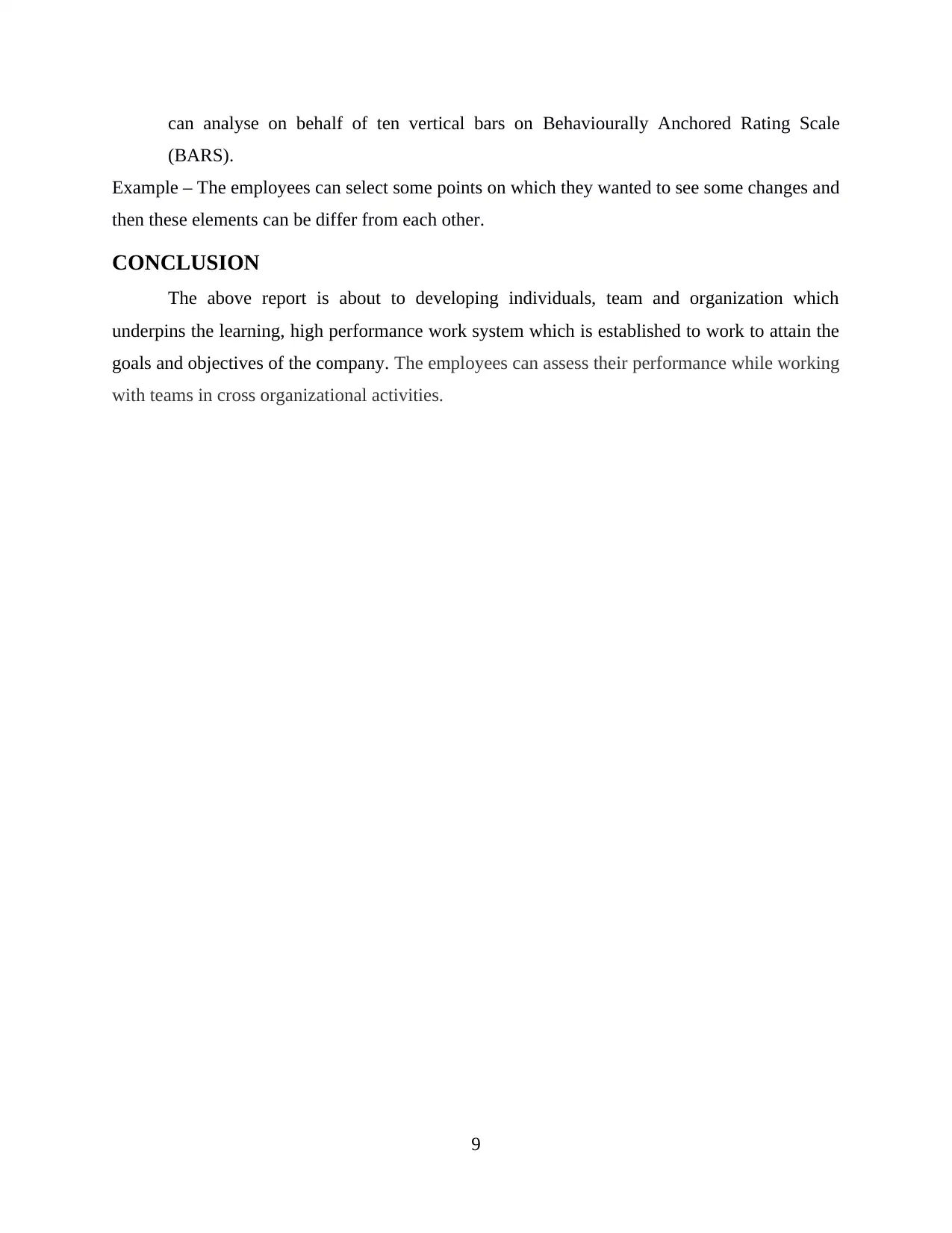
can analyse on behalf of ten vertical bars on Behaviourally Anchored Rating Scale
(BARS).
Example – The employees can select some points on which they wanted to see some changes and
then these elements can be differ from each other.
CONCLUSION
The above report is about to developing individuals, team and organization which
underpins the learning, high performance work system which is established to work to attain the
goals and objectives of the company. The employees can assess their performance while working
with teams in cross organizational activities.
9
(BARS).
Example – The employees can select some points on which they wanted to see some changes and
then these elements can be differ from each other.
CONCLUSION
The above report is about to developing individuals, team and organization which
underpins the learning, high performance work system which is established to work to attain the
goals and objectives of the company. The employees can assess their performance while working
with teams in cross organizational activities.
9
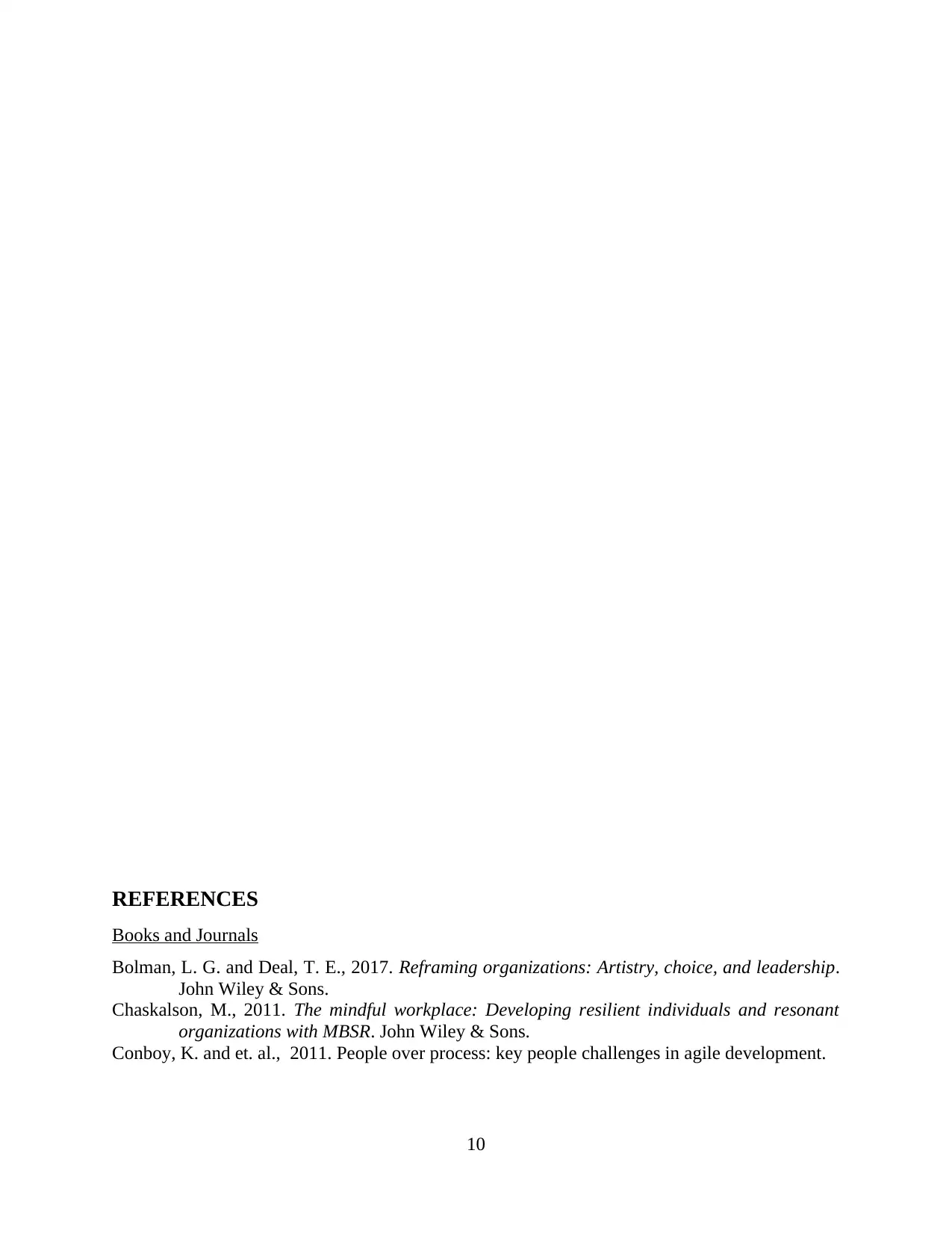
REFERENCES
Books and Journals
Bolman, L. G. and Deal, T. E., 2017. Reframing organizations: Artistry, choice, and leadership.
John Wiley & Sons.
Chaskalson, M., 2011. The mindful workplace: Developing resilient individuals and resonant
organizations with MBSR. John Wiley & Sons.
Conboy, K. and et. al., 2011. People over process: key people challenges in agile development.
10
Books and Journals
Bolman, L. G. and Deal, T. E., 2017. Reframing organizations: Artistry, choice, and leadership.
John Wiley & Sons.
Chaskalson, M., 2011. The mindful workplace: Developing resilient individuals and resonant
organizations with MBSR. John Wiley & Sons.
Conboy, K. and et. al., 2011. People over process: key people challenges in agile development.
10
⊘ This is a preview!⊘
Do you want full access?
Subscribe today to unlock all pages.

Trusted by 1+ million students worldwide
1 out of 14
Related Documents
Your All-in-One AI-Powered Toolkit for Academic Success.
+13062052269
info@desklib.com
Available 24*7 on WhatsApp / Email
![[object Object]](/_next/static/media/star-bottom.7253800d.svg)
Unlock your academic potential
Copyright © 2020–2025 A2Z Services. All Rights Reserved. Developed and managed by ZUCOL.





